

Getting on the Map: The Intro to Local SEO for SABs. Local SEO can be confusing for those businesses that don’t have a physical store for customers to walk into.

Unlike businesses with a brick-and-mortar storefront, service-area businesses (or SABs) go out to meet with their customers, as opposed to their customers coming to see them. This often results in them servicing multiple cities, which can be problematic—the #1 ranking factor in local SEO is the physical address of the business. In addition, business owners are also usually concerned about privacy, as many of them use their home address and can’t utilize some of the features that Google offers small businesses (like Indoor Street View). Google's Local Snack Pack Shake-Up: What You Need to Know. Local SEO has seen the biggest shake-up since Google launched their first local algorithm, Pigeon, just over a year ago.
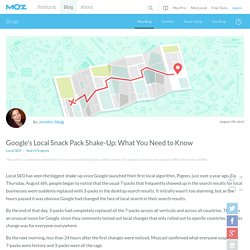
On Thursday, August 6th, people began to notice that the usual 7-packs that frequently showed up in the search results for local businesses were suddenly replaced with 3-packs in the desktop search results. It initially wasn't too alarming, but as the hours passed it was obvious Google had changed the face of local search in their search results. By the end of that day, 3-packs had completely replaced all the 7-packs across all verticals and across all countries. This was an unusual move for Google, since they commonly tested out local changes that only rolled out to specific countries. But this change was for everyone everywhere. By the next morning, less than 24 hours after the first changes were noticed, Mozcast confirmed what everyone suspected: 7-packs were history and 3-packs were all the rage. Someone else verified my business - Google My Business Help.
Some businesses have already been verified by an owner or manager and have a Google My Business listing.

The listing is owned by the person who verified the business. Someone else verified my business - Google My Business Help. How to Craft the Perfect Local SEO Strategy - Ignite Visibility. In today’s world, phone books are basically extinct.
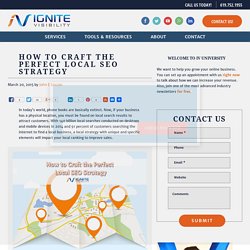
Local Search Ranking Factors 2013 - Local SEO and How to Rank in Google. Local Pack/Finder Ranking Factors Google My Business Signals (Proximity, categories, keyword in business title, etc.) 25.12%Link Signals (Inbound anchor text, linking domain authority, linking domain quantity, etc.) 16.53%Review Signals (Review quantity, review velocity, review diversity, etc.) 15.44%On-Page Signals (Presence of NAP, keywords in titles, domain authority, etc.) 13.82%Citation Signals (IYP/aggregator NAP consistency, citation volume, etc.) 10.82%Behavioral Signals (Click-through rate, mobile clicks to call, check-ins, etc.) 9.56%Personalization 5.88%Social Signals (Google engagement, Facebook engagement, Twitter engagement, etc.) 2.82% Localized Organic Ranking Factors Introduction Another year, and another Local Search Ranking Factors survey is here.
My apologies for being late with it again. My thoughts and summary of the survey results can be found here on the Moz Blog, and I would love to hear your thoughts and questions in the comments section here. Definitions. How to Boost Your Local SEO Rankings with Google+ It should go without saying that a company’s Google+ Page signals (ie. any Google property’s signals) have a significant impact on its organic — and more specifically, local pack — results.
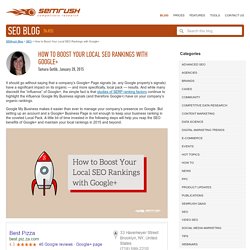
And while many discredit the “influence” of Google+, the simple fact is that studies of SERP ranking factors continue to highlight the influence Google My Business signals (and therefore Google+) have on your company’s organic rankings. Google+ My Business Page Finder. This tool uses the Google Places API to return all Google My Business pages that Google thinks might possibly match the business name and zip code you entered (non US postal codes will work as well).
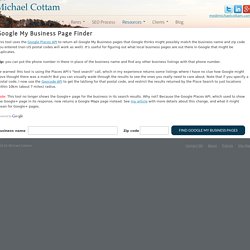
It's useful for figuring out what local business pages are out there in Google that might be duplicates. Tip: you can put the phone number in there in place of the business name and find any other business listings with that phone number. Be warned: this tool is using the Places API's "text search" call, which in my experience returns some listings where I have no clue how Google might have thought there was a match! Every Local SEO Diagnostic You’ll Ever Need to Know (Plus Some) You may be stumped as to why you’re not ranking well (or at all)…but don’t say it’s because you tried everything and just couldn’t figure it out.
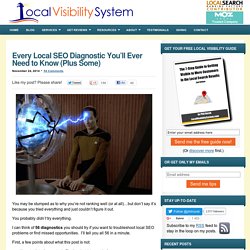
You probably didn’t try everything. How to Perform the Ultimate Local SEO Audit. The author's posts are entirely his or her own (excluding the unlikely event of hypnosis) and may not always reflect the views of Moz.

Every business that competes in a local market and who competes for the display of localized results in SERPs will likely find the need to conduct a local SEO audit at some point. Whether you've hired an SEO in the past or not, the best way to beat the competition is to know where you stand and what you need to fix, and then develop a plan to win based on the competitive landscape. While this may seem like a daunting task, the good news is that you can do this for your business or your client using this Ultimate Local SEO audit guide.
This guide was created as a complete checklist and will show you what areas you should focus on, what needs to be optimized, and what you need to do to fix any problems you encounter. To make things easier, I have also included many additional resources for further reading on the topics below.